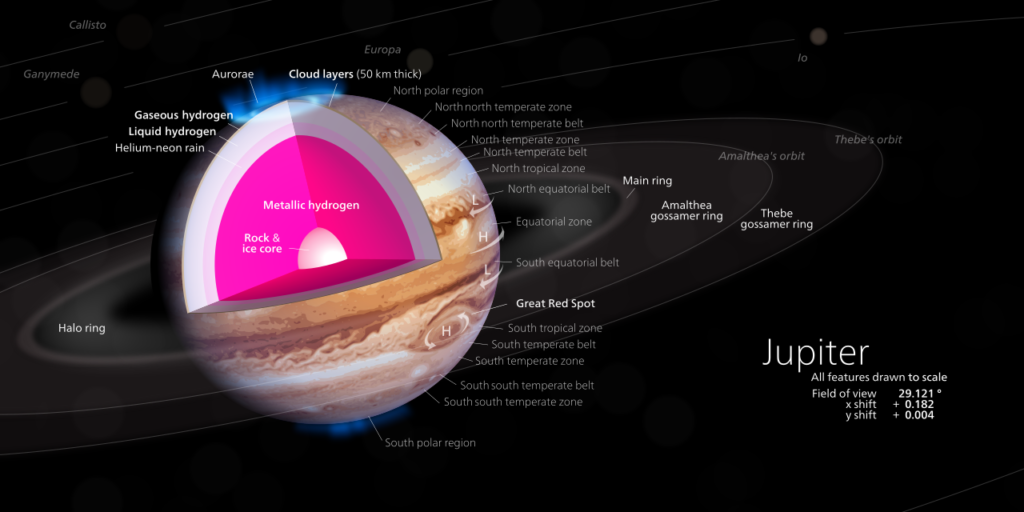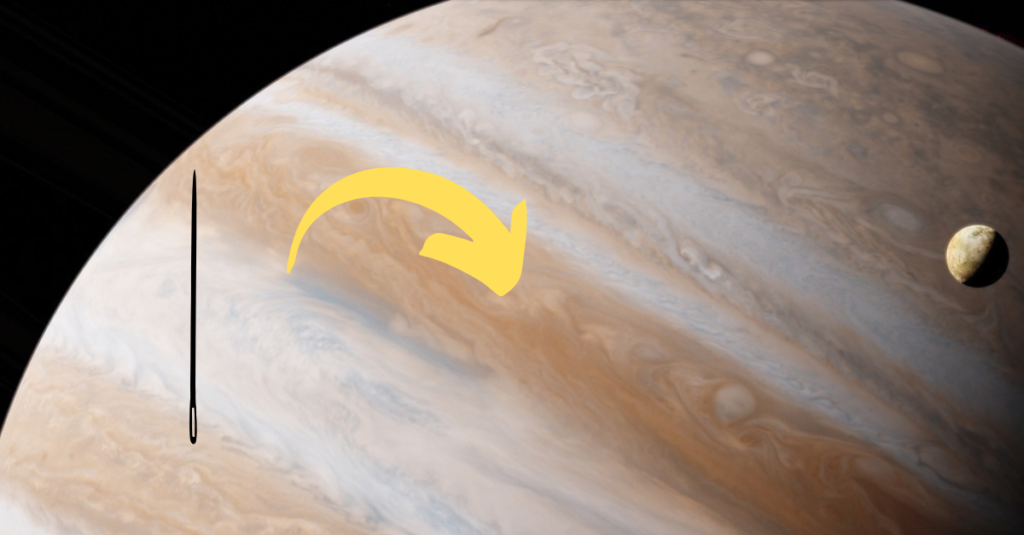Jupiter is a gas giant. Scientists can only theorize about how many layers it has, how dense these layers are and what its core looks like. If a needle hits Jupiter at the speed of light, it will burst like a balloon and fly out of the solar system.
A needle travelling at extremely high speeds is expected to penetrate the gas giant easily. The concept of a needle piercing through Jupiter at high speeds is a topic of scientific discussion. While it is theorized that a needle travelling at the speed of light would reach the centre of Jupiter in less than half a second, it is essential to note that this is still just a theory and has not been proven. Additionally, the composition of Jupiter’s core is still not fully understood. The most widely accepted theory is that it is composed of an extreme substance known as metallic hydrogen. However, more research is needed to understand the properties and structure of Jupiter’s core fully.
Theory of a Needle Hitting Jupiter
In 2017, scientists from Harvard University, Isaac Silvera and Renga Diaz, made a groundbreaking discovery by successfully synthesizing metallic hydrogen at a pressure of 500 gigapascals, which is 5,000,000 times greater than Earth’s atmospheric pressure. In the laboratory, the substance lasted only a few seconds before evaporating. However, it is believed that due to the extreme conditions within Jupiter, large quantities of metallic hydrogen may exist at the planet’s core.
According to the theory of relativity, at the speed of light, the energy of even a tiny amount of matter, such as 2/10 of a gram, would be virtually infinite. This means that upon collision with the first atom of Jupiter’s atmosphere, the needle would transform into a powerful pulse of energy, effectively destroying the entire gas layer surrounding Jupiter. The intense pressure and heat generated by this impact would likely cause the metallic hydrogen in the core to evaporate.
Composition of Jupiter’s Core

Scientists have yet to understand Jupiter’s physics fully, and there is an ongoing debate about the nature of its core. Some theories suggest that it may not be solid but a liquid composed of hydrogen with metallic properties, which would generate a magnetic field. If this is the case, then a needle launched at the speed of light would likely have a destabilizing effect on all of the internal layers of Jupiter due to its impact.
How Will a Needle Hit Jupiter?
Initially, the needle would slice through the ammonia clouds on Jupiter’s surface. At a depth of 250 kilometres, it would encounter a layer of gaseous hydrogen mixed with traces of helium. While the needle may not heat up from friction, it would undoubtedly heat the surrounding atmosphere. Since hydrogen is highly flammable, it could explode with a single spark. However, oxygen is also required for an explosive mixture to occur, which is not present in Jupiter’s atmosphere.
Impact of Needle on Jupiter
The potential impact of a needle crashing into Jupiter’s core at the speed of light could be catastrophic, potentially triggering a chain reaction that leads to an explosion of immense power. It is worth considering that the weight of a typical metal needle is insignificant in comparison, weighing only 2/10 of a gram, while Jupiter’s mass is measured in octillions of kilograms. This significant disparity in size is even more pronounced when compared to a human and a bacterium.
An impact of a needle travelling at the speed of light to the core of Jupiter could lead to significant changes in its shape and gravity, potentially causing disruptions to the orbits of its satellites. Furthermore, if the core of Jupiter were to be composed of liquid hydrogen, the intense compression caused by the needle could result in a powerful and unpredictable event. In other words, all the conditions for a nuclear reaction like in the very centre of the sun.
The gas giant will become an enormous gas cloud, quickly spreading throughout the solar system and creating a chain reaction. Now Jupiter holds thousands of asteroids of various sizes in its orbit, and if Jupiter suddenly evaporates, it scatters randomly, crashing into all the planets in a row. Additionally, the sudden loss of the most vital gravitational force apart from the sun will throw the system off balance.
The orbits of inner planets like Earth will narrow so that we can expect asteroid bombardments and unbearable heat that can be deadly to all living things.
Conclusion
In conclusion, no object can travel at the speed of light. But in this hypothetical scenario, if a needle hits Jupiter at the speed of light, it will burst or destroy our solar system.

